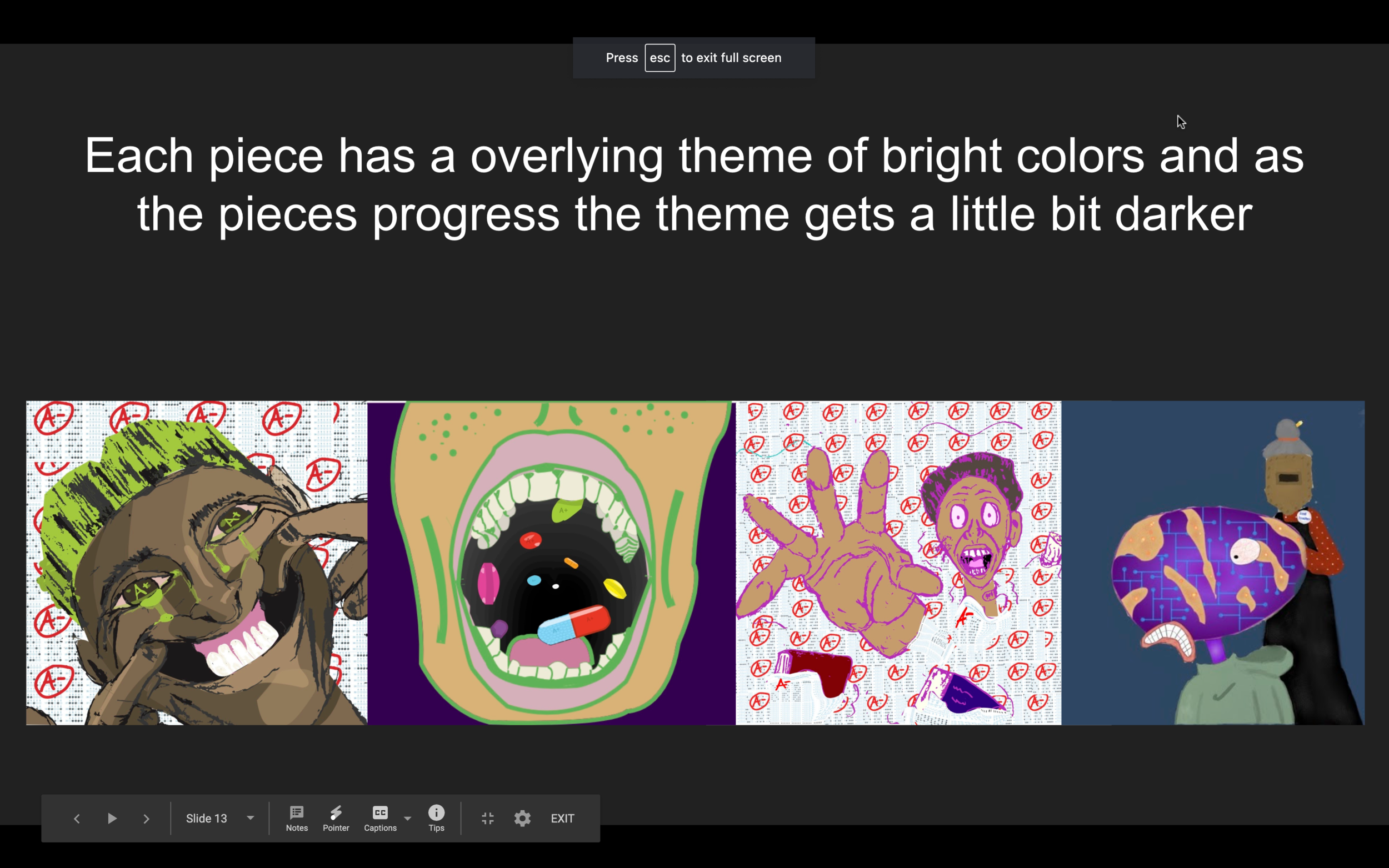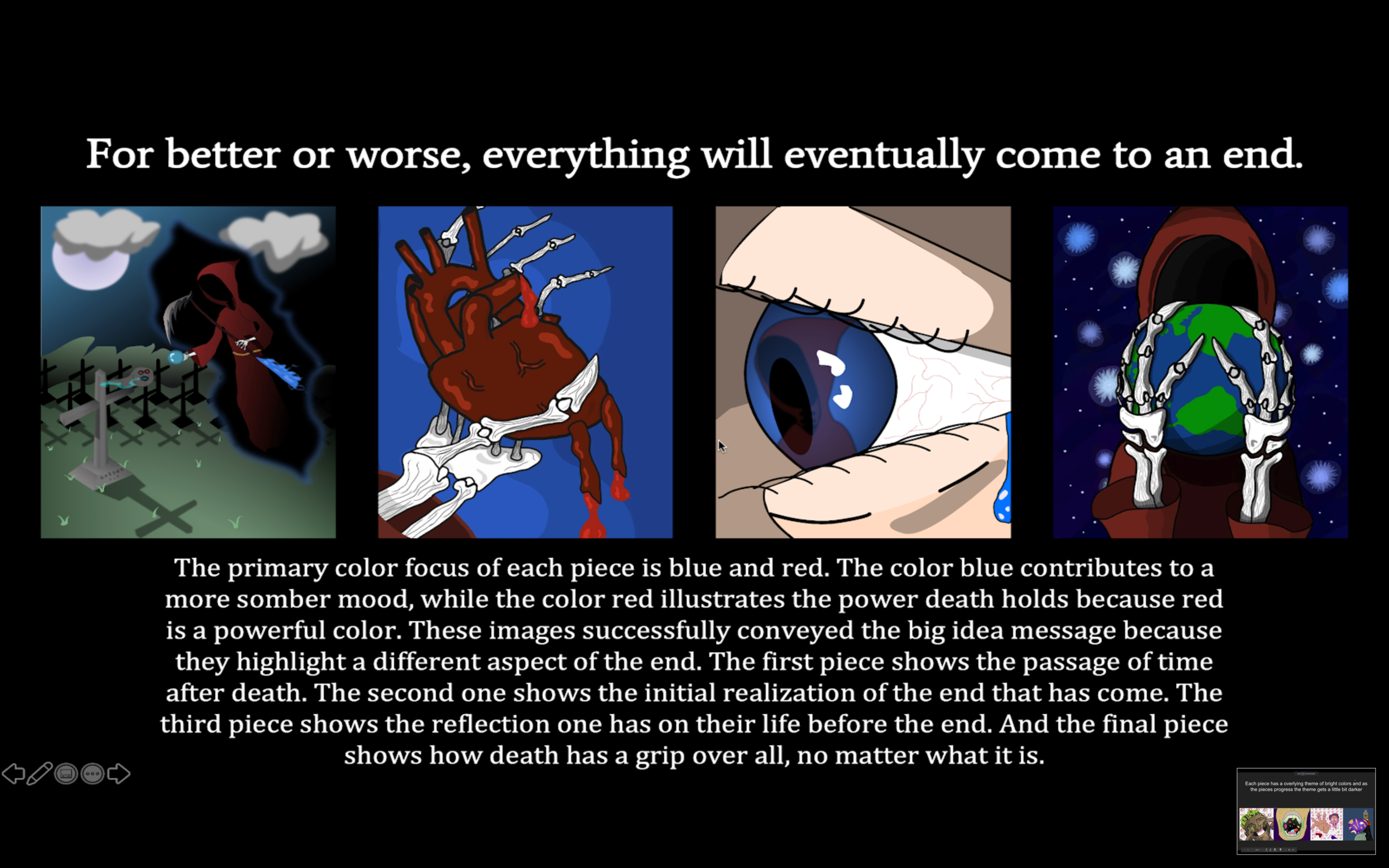Sooo….this blog post is some visual documentation of my experience with teaching the Big Ideas framework and lesson plan. In my last post, I talked about the rollout and execution of the first iteration of this plan. I will show some images, sketches and final pieces from that experience, as well as some images from the current version that is ongoing and my observations and reflections so far.
The whole purpose of the lesson as laid out in Dr. Sydney Walker’s book, Teaching Meaning in Artmaking (Walker, 2001) is for students to be able to create meaning with their visual arts. As a review, students in the Big Idea lesson plan choose from a set of big ideas, broad humanistic concerns, and create a series of artworks built around their inquiries into investigating the different facets of that big idea. The thought process behind this is the student will attain a higher level of learning if they are using a skill towards a goal they understand...and even more so if they play a part in creating/conceiving that goal (A.C. Statten, 2014).
Naomi Goosby, Final Presentation Slide. 2020
Students investigate these big ideas with what Walker calls, Essential Questions. Essential Questions are questions that explore the Big Idea statement. These inquiries help the student artist articulate their personal experiences and beliefs through and into the art (Walker, 2001). This is an ongoing process where students will come up with questions around their big idea and “stew” on them. They will brainstorm, rotate and reconceive these inquiries, sketch and try and visualize solutions or explore ways to represent the meaning visually. Essentially they will go down a rabbit hole investigating and trying to deliver their intended meaning.
Jordan Orozco, Sketches and research. 2021
Now the essential questions, which in my class were delivered in weekly sketches and notes are where I found the most growth and movement in the lesson. Students who were actually going through this process of rotating and reconstructing their questions and findings were able to articulate meaning and generate multiple ideas for their pieces. I encouraged students to not only use images in the form of sketches and photo reference, but also incorporate writings, songs, poems and citations.
This ongoing process allowed a flow of ideas that was exciting to see come into existence. I noted that some students had more ideas and directions than they could focus into a series of pieces while others struggled to be a part of the weekly discussion for lack of research into their big idea. The process of conceptualizing and refining the idea for a piece or series of artwork was foreign to my students. Some took the process and embraced it, while others tried to make “art class” work like it had in the past: see project, step 1, step 2, step 3, finish and leave.
I used the metaphor of a sports team that showed up for the first day of training. Upon arrival, the coach informs the players that they had their first game in three weeks, however, they would not be doing any practicing or exercise in preparation for the game. Instead, they would rely on whatever knowledge they had and just show up for the game and hope for the best. This of course seems silly to my students, yet it is the same approach that many of them bring into the art studio…digital or otherwise. Instead of doing any preparation, they just jump straight to the final and feel unsuccessful with their efforts, declaring that they must simply “not be any good at art.”
Amya Howard, Sketches and Research 2020
Another essential part of the process that proved to be very useful was the informal group critique. My students all seemed to benefit from sharing, reflecting and hearing peer feedback. We would spend three weeks on an individual piece in the series. Week one would end with an initial idea generated from the essential question they chose to investigate. Essentially, they would share their research…notes, sketches, photo reference. By bouncing these ideas around the room, often times different perspectives would reveal themselves that the originator had not considered.
One such notable experience happened with one student. Her big idea was the effects that music had upon a person over the course of a lifetime. She was weaving concepts of mother and child bonding and parental influence upon dreams and desires. She had shown the birth of the character with mother and music present and was in the process of showing a progression into adulthood taking those influences with her. Her image idea had the character on stage, a silhouetted crowd observing her perform in the spotlight. Another student commented on the mother being absent from the scene and it was discussed how the mother could somehow be incorporated as a member of the audience and highlighted in color or light. This was an moment where her art took a direction that carried deeper visual meaning and brought a sense of success and accomplishment to her big idea.
Amya Howard, Final Presentation Big Idea 2020
Fast forward to the present, where a new series of the big idea lesson plan is in full swing. My biggest revamp on the program is introducing a sense of flexibility. This is very easy to do with a smaller group and may prove very challenging in a larger class. However, I believe that it adds a realistic and noteworthy learning aspect about art and art practices to young artists.
Jordan Orozco, Final Presentation Big Idea 2020
The current version of the lesson involves a series of five pieces around one big idea and a final presentation. My students who are moving through this process are using the tools and processes to their advantage, generating ideas and possible routes to investigate. The versatility comes into practice when a student gets stuck. We all as artists or otherwise will reach a point in a project where we have done all of the right steps and somehow we feel like something is off. Even when you go back, disassemble, investigate and then reassemble concepts, you still can end up at a dead end. Giving my students “the permission” to step back from a piece and start on another is valuable because it is important to the creative process. I put permission in quotes, because that is how my students frame it…like they need my approval to step back and work their way through a creative roadblock. I note to my students that I usually have multiple projects going on, many within my sight, just for that reason. Put it down, step back and walk away. Revisit it later and see if you have gained any new insights. Usually if an artistic conundrum has presented itself to me, I will continue to work on it in my head even if it is not the task at hand.
Doom Mask. Jordan Orozco 2021
I will continue to refine and push this lesson framework forward because it provides a powerful and useful lesson: meaning making in art. Students can see recurring themes, colors and processes in series of work, all from their own idea generation. They see the impact of their research and how it can blossom into bigger things. They learn as young artists to thrive in a creative atmosphere and feed off each other’s motivation and excitement for expression.
Student work show with written permission.
References
A.C. Stratten, August 27, 2014. So What is the Big Idea?https://whatitmeansforart.wordpress.com/2014/08/27/big-idea-2/
A.C. Stratten, September 02, 2014. Big Ideas for Instruction https://whatitmeansforart.wordpress.com/2014/09/02/big-ideas-3/
Walker, S. (2001). Teaching Meaning in Artmaking (Davis Publications, 2001)






